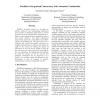Free Online Productivity Tools
i2Speak
i2Symbol
i2OCR
iTex2Img
iWeb2Print
iWeb2Shot
i2Type
iPdf2Split
iPdf2Merge
i2Bopomofo
i2Arabic
i2Style
i2Image
i2PDF
iLatex2Rtf
Sci2ools
IPPS
2006
IEEE
2006
IEEE
Workflow fine-grained concurrency with automatic continuation
Workflow enactment systems are becoming an effective solution to ease programming, deployment and execution of distributed applications in several domains such as telecommunication, manufacturing, ebusiness, e-government and grid computing. In some of these fields, efficiency and traffic optimization represent key aspects for a wide diffusion of workflow engines and modeling tools. This paper focuses on a technique that enables fine-grained concurrency in compute and data-intensive workflows and reduces the traffic on the network by limiting the number of interactions to the ones strictly needed to bring the data where they are really necessary for continuing the flow of computations. We implemented this technique by using the concepts of wait by necessity and automatic continuation and we integrated it in a flexible, Java workflow engine that through the new mechanisms is able to navigate a workflow anticipating the enactment of sequential activities.
Distributed And Parallel Computing | IPPS 2006 | Java Workflow Engine | Workflow Enactment Systems | Workflow Engine |
| Added | 12 Jun 2010 |
| Updated | 12 Jun 2010 |
| Type | Conference |
| Year | 2006 |
| Where | IPPS |
| Authors | Giancarlo Tretola, Eugenio Zimeo |
Comments (0)

